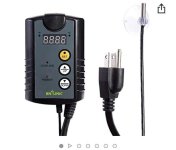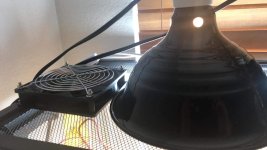SpottedDragon
Member
I listened to an interesting CE on reptile husbandry from a veterinary standpoint earlier in the week, and these Deep Heat Projectors are getting popular for recover cages and being recommended over other forms of heating. But I also know from experience that veterinary medicine that is based solely on science isn't always practical for keepers.
The talk was on preventing GI stasis during and after illness / surgery / and treatments. Basically, the way the deep heat projectors work is more natural in that it heats the actual muscles under the skin both directly as radiation and via conduction from basking on natural substrate such as rocks. It helps 'keep them regular', esp if they are on antibiotics or have had anesthesia.
The thought was that UTH heat and heat from overhead CHE's or Bulbs are inefficient at deep tissue warming and have a narrow 'beams' that heat the substrate directly in a small area making the temperature gradient more ... harsh ... if that makes sense - like there are boundaries between what is warm and what is cool instead of small gradual changes.
The idea is that the deep heat encourages basking behavior and helps the gut move more effectively than belly heat alone, and even better than CHEs and Bulbs. This helps also with UVB absorption as long as the UVB bulb overlaps with the heat. *But* it seems to also rely on both having UVB of the right strength and thicker dark natural stone in the "basking" zone to be effective. Just a tile floor wouldn't be enough. Also this helps them identify where the "sun" and "shade" are.
Just wondering if any keepers out there have these projectors or have switched from more mainstream methods of heating and if so, did they notice any change in the behavior of their lizards?
I would be willing to try it as an experiment, (esp now that I am up grading my female's entire set up and have to buy a new UTH anyway), but am curious as I haven't really heard much about them before.
https://media.discordapp.net/attach...4208410132520/thermo.JPG?width=527&height=442
Basically when we keep the air temp at a constant or narrow range then keep a UTH as the hot spot, we are preventing all the other types of heating, which while isn't technically bad, isn't as natural as it could be.
The talk was on preventing GI stasis during and after illness / surgery / and treatments. Basically, the way the deep heat projectors work is more natural in that it heats the actual muscles under the skin both directly as radiation and via conduction from basking on natural substrate such as rocks. It helps 'keep them regular', esp if they are on antibiotics or have had anesthesia.
The thought was that UTH heat and heat from overhead CHE's or Bulbs are inefficient at deep tissue warming and have a narrow 'beams' that heat the substrate directly in a small area making the temperature gradient more ... harsh ... if that makes sense - like there are boundaries between what is warm and what is cool instead of small gradual changes.
The idea is that the deep heat encourages basking behavior and helps the gut move more effectively than belly heat alone, and even better than CHEs and Bulbs. This helps also with UVB absorption as long as the UVB bulb overlaps with the heat. *But* it seems to also rely on both having UVB of the right strength and thicker dark natural stone in the "basking" zone to be effective. Just a tile floor wouldn't be enough. Also this helps them identify where the "sun" and "shade" are.
Just wondering if any keepers out there have these projectors or have switched from more mainstream methods of heating and if so, did they notice any change in the behavior of their lizards?
I would be willing to try it as an experiment, (esp now that I am up grading my female's entire set up and have to buy a new UTH anyway), but am curious as I haven't really heard much about them before.
https://media.discordapp.net/attach...4208410132520/thermo.JPG?width=527&height=442
Basically when we keep the air temp at a constant or narrow range then keep a UTH as the hot spot, we are preventing all the other types of heating, which while isn't technically bad, isn't as natural as it could be.
Last edited:



